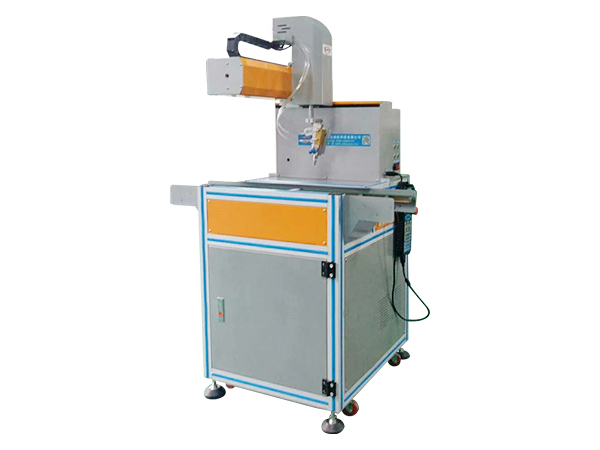The online dispensing machine is a high-precision fluid control device integrated into an automated production line. Through the coordinated control of mechanics, electricity and software, it achieves continuous, stable and precise distribution of glue. Its core advantage lies in seamless integration with upstream and downstream equipment, supporting high-speed production rhythms while ensuring consistent dispensing quality. It is widely used in industries with extremely high requirements for production efficiency, precision and reliability. The following is an analysis of its typical application scenarios and technical compatibility:
I. 3C Electronic Product Manufacturing: Miniaturization and High Precision Requirements
Assembly of mobile phones/tablets
Application scenarios: camera modules, fingerprint recognition modules, screen frame sealing, battery compartment bonding, etc.
Technical adaptation
Micro-dispensing: Utilizing piezoelectric jet valves or screw valves, it achieves 0.01mm-level glue line control (for instance, the width of the edge sealant of the camera module is ≤0.2mm).
High-speed production: Synchronized with surface mount technology (SMT) machines and assembly lines, the dispensing speed reaches 200-500 dots per minute (for example, the dispensing cycle of the middle frame of a mobile phone is ≤0.8 seconds per dot).
Material compatibility: Supports various adhesives such as UV glue, silicone, and epoxy resin, meeting the bonding requirements of different components (for example, fast-drying UV glue is needed for screen frames).
Case: A certain mobile phone manufacturer has increased the yield rate of camera module dispensing from 98% to 99.8% through an online dispensing machine, and the single-line production capacity has increased by 40%.
Production of wearable devices
Application scenarios: Bonding of smartwatch dials, sealing of TWS earphone charging cases, fixing AR/VR lenses, etc.

Technical adaptation
Three-dimensional dispensing: Equipped with a multi-axis mechanical arm, it achieves uniform gluing on curved surfaces or irregular structures (such as 360° sealing of the edge of a smartwatch dial).
Low pressure control: Prevent the glue from penetrating into sensitive components (for example, the dispensing pressure of AR lenses is ≤0.1MPa to prevent the decline of optical performance).
Visual guidance: Real-time correction of the dispensing position deviation through a CCD camera (for example, the dispensing accuracy of the TWS earphone charging case is ±0.05mm).
Ii. Automotive Electronics and Components: High reliability and environmental resistance
Assembly of in-vehicle display screens
Application scenarios: Frame sealing and structural bonding for central control screens, instrument panels, and HUD head-up displays.
Technical adaptation
Large-sized dispensing: Use gantry-type robotic arms or track-type platforms to cover display screen sizes over 1.5 meters (for example, the dispensing path length of the central control screen of Tesla Model S is ≥2m).
High-temperature resistant glue: Supports materials such as silicone and polyurethane, suitable for the high-temperature environment inside the vehicle (for example, components in the engine compartment need to use glue resistant to 150℃).
Online detection: Integrated laser height gauge, real-time monitoring of the thickness of the adhesive layer (for example, the thickness of the adhesive layer on the display screen frame needs to be controlled at 0.3±0.05mm).
Case: A certain automobile manufacturer has reduced the defect rate of in-vehicle display screen dispensing from 2% to 0.1% through an online dispensing machine, and shortened the production cycle to 15 seconds per unit.
Production of sensors and actuators
Application scenarios: Air flow sensors, pressure sensors, motor stator potting, etc.
Technical adaptation
Micro-dispensing: Piezoelectric ceramic valves are adopted to achieve nano-upgrade (nL) precision control (for example, the dispensing amount of MEMS sensors is ≤0.1μL).
Vacuum environment dispensing: Avoid bubble formation (for example, motor stator potting should be completed in a vacuum environment of -80 kpa).
Multi-component mixing: Supports the proportionally mixing of two-component adhesives (such as epoxy resin + curing agent) to meet the requirements of high-strength bonding.
Iii. Semiconductor and LED Packaging: Ultra-Precision and Cleanliness Requirements
Chip packaging
Application scenarios: Underfill, Dam&Fill, etc. for packaging forms such as QFN, BGA, and CSP.
Technical adaptation
Nanomet-level precision: By using screw pumps or piezoelectric jet valves, the width of the glue line is achieved to be ≤0.1mm (for example, the width of the glue line for bottom filling of BGA chips is 0.08mm).
Dust-free environment: The equipment must meet the Class 100 clean standard to prevent glue from contaminating the chips (for example, the cleanliness of the semiconductor packaging workshop should be ≤100 pieces /ft³).
Online curing: Integrated UV lamp or infrared heating module to achieve immediate curing after dispensing (such as QFN encapsulation point dispensing - curing cycle ≤5 seconds).
Case: A certain semiconductor manufacturer has increased the yield rate of chip packaging dispensing from 95% to 99.5% through an online dispensing machine, and the single-line production capacity has been tripled.
Production of LED lamps
Application scenarios: LED lamp bead fixation, lens bonding, power module sealing, etc.
Technical adaptation
High light transmittance glue: Supports materials such as silicone and organosilicon, avoiding light refraction loss (for example, glue with a refractive index of 1.4-1.5 is needed for LED lens dispensing).
Fast curing: Utilizing UV glue or quick-drying epoxy resin, it is suitable for high-speed production lines (for instance, the dispensing speed of LED light strips can reach 10 meters per minute).
Phosphor mixing: Through an online mixing system, uniform mixing of glue and phosphor is achieved (for example, in COB LED packaging, the proportion of phosphor needs to be precisely controlled).
Iv. Medical Devices and Biotechnology: Biocompatibility and Sterility Requirements
Production of medical consumables
Application scenarios: syringe piston bonding, drip bucket sealing of infusion sets, catheter fixation, etc.
Technical adaptation
Biocompatible adhesive: Supports medical-grade silicone, polyurethane and other materials, and complies with ISO 10993 biosafety standards.
Aseptic dispensing environment: The equipment must undergo EO sterilization or radiation sterilization treatment to prevent cross-contamination (for example, the cleanliness level of the dispensing workshop for disposable syringes should be ≤ grade 10).
Micro-control: High-precision screw valves are adopted to achieve 0.01μL level dispensing (for example, the dispensing volume of microfluidic chips is ≤0.05μL).
Case: A certain medical enterprise has reduced the leakage rate of syringe piston bonding from 3% to 0.05% through an online dispensing machine, and increased production efficiency by 50%.
In vitro diagnostic (IVD) equipment
Application scenarios: Reagent card assembly, microfluidic chip sealing, biosensor fixation, etc.
Technical adaptation
High-precision positioning: The micro-well position is identified through the visual system, with a deviation of ≤0.02mm (for example, the dispensing accuracy of the reagent card sample loading hole is ±0.01mm).
Low residue dispensing: Non-contact injection valves are adopted to prevent glue from contaminating the reaction zone (for example, the residual amount of glue in PCR chip dispensing is ≤0.001mg).
Multi-variety switching: Supports rapid type change to meet the production needs of different reagent cards (for example, it only takes 10 minutes to switch from COVID-19 reagent cards to influenza reagent cards).
V. New Energy and Industrial Control: Corrosion Resistance and High-temperature Performance
Production of lithium batteries
Application scenarios: Bonding of battery cell tabs, sealing of battery packs, fixation of BMS modules, etc.
Technical adaptation
Conductive adhesive dispensing: Conductive materials such as silver paste or carbon paste are used to achieve electrical connection between the tabs and the battery cells (for example, the dispensing resistance of the tabs in square batteries is ≤5mΩ).
Electrolyte resistant adhesive: Supports materials such as polyurethane and acrylic, and resists electrolyte corrosion (for example, the sealing adhesive for cylindrical batteries needs to be resistant to LiPF6 electrolyte).
Online detection: Integrated conductivity tester, real-time monitoring of the connection quality of conductive adhesive (for example, the conductivity of the TAB after dispensing should be ≥90%IACS).
Case: A certain battery manufacturer has increased the yield rate of cell TAB bonding from 92% to 99% through an online dispensing machine, and shortened the production cycle to 2 seconds per cell.
Assembly of industrial controllers
Application scenarios: PCB board conformal coating, heat sink thermal grease filling, connector sealing, etc.
Technical adaptation
Selective coating: The visual system identifies the area to be coated to avoid contaminating sensitive components (such as the coating area accuracy of PCB boards ±0.1mm²).
High thermal conductivity materials: Support thermal conductive fillers such as boron nitride and alumina to achieve efficient heat dissipation (for example, the thermal conductivity of thermal silicone grease for IGBT modules ≥3W/m·K).
Anti-static design: The equipment casing should be grounded to prevent the glue from adhering to dust (for example, the humidity in the industrial controller dispensing workshop should be controlled at 40%-60%RH).
about
Introduction video case honor partners factoryproduct
Automatic welding line Non-standard customization Automatic soldering Glue/screw lockingnews
dynamic Information faqCustomer Service
contactMr. Xia:+86 186-7696-3763

WeChat QR code

Douyin QR Code
Copyright © 2025 Copyright © Dongguan Chuangxiao Automation Technology Co., Ltd.
本站相关网页素材及相关资源均来源互联网,如有侵权请速告知,我们将会在24小时内删除